Tools of the Trade
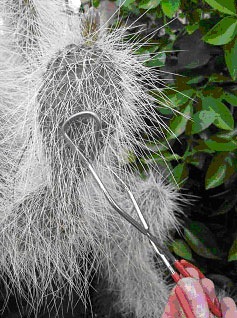 When dealing with Cacti, some precautions must be taken. They certainly aren't the most cuddly of plants!
When dealing with Cacti, some precautions must be taken. They certainly aren't the most cuddly of plants!
When it comes to repotting, planting, pricking out seedlings, etc., all these tasks require some special tools.
This does not mean expesive specialty tools, quite the opposite, this means getting innovative and creating
your own tools for mere pennies.
I've come across some cool little tools and wanted to share them with all our customers. I'm sure most of this
is common knowledge among experienced growers, but maybe this article could still provide some new tips and will
hopefully help the newer cactiphiles.
Of course, some gardening tools are obvious and widely known and used, however, I know there are some of you out
there that have created your own tools for either special purposes or just to make your life easier. So I've put
together an article to display different useful tools and other helpful ideas from myself and other growers/collectors.
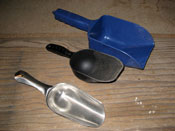 |
1. Soil Scoops
Plastic dog food scoops make great shovels for repotting. They come in various sizes and shapes for use
with all types of pots and plants. They are usually plastic, although I found a nice stainless steel
scoop that we use for adding gravel/rocks for top dressings. It's all in the shape of the scoop that
helps to get under the spines and offsets/pups when adding soil. You could also find lots of choices
at a home store kitchen dept. (i.e. Target, Bed-Bath and Beyond, Sears) Eating spoons can also be used
for very tricky spots or very small cacti seedlings or densely clumped plants bearing many offsets, pups, etc.
|
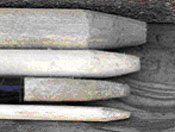
Wooden Dowels Shaped

Wooden Dowel Color Codes
|
2. Pokers, Tampers, Widgers and Dibbers
Wooden dowels make great potting tools. With a little customizing using a Dremel, sand paper or bench
grinder, you can make them into any shape for whatever use you need them for. The dowels usually come
in 4 foot lengths and come in various diameters, each being color coded. They are very inexpensive, so
it's easy to get one of each size and have one for just about any occasion. Using a saw to cut them into
whatever length strips you desire and then shaping one end to a dull point. These can be used for poking
soil into the roots when potting, for teasing out the roots, tamping (or packing) down the soil around
the plant and can be used as holders for potting some of the really spiny ones (i.e. Ferocactus, Echinocactus, etc.)
by placing them across the pot in a bridge formation to hold the plant, leaving both hands free to add soil.
These can also be used as dibbers. Using the smaller diameter dowels and shaping them to whatever size you need.
I've also used paint stir sticks. But found them to be a bit cumbersome to hold. The round dowels feel much more
comfortable and you're able to use them with more dexterity. It's all in how you use your Dremel to shape
them. You can shape the paint stir sticks into a scoop at one end to be used as widgers. They also make good
shoehorns to get plants out of their pots. Wood dowels and stir sticks (stir sticks are usually free!!) can be
found at your local lumber/hardware/home improvement store.
|
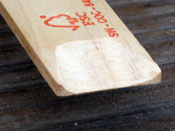
Paint Stir Stick
|
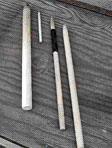
Wooden Dowels Cut to Size
|
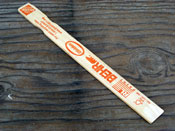
Paint Stir Stick
|
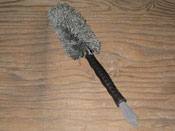
Automotive Detail Brush

Automotive Detail Brush
|
3. Brushes
While small paint brushes are used for pollination, they can also be used for cleaning off soil,
cobwebs, leaves, etc. from the spines with very minimal damage. However, I found that an automotive
interior detail brush can work just as well for cleaning. The bristles are stiffer than a paint brush
and can clean even some of the heavily wooly plants with ease. Paint brushes can be found at any arts
supply store. Detail brushes can be found at any automotive store.
Old toothbrushes also make good cleaners. Gives you bit of a reach too.
|

Various Length Tweezers

Tongs
|
4. Tweezers, Tongs, Strainers and Sieves
Tweezers are common tools used in maintenance for cleaning out tough to get at leaves, weeds, grass, etc. Also
makes for easy seed pod and fruit collecting. Tweezers come in all sizes, from small 4inch up to 15inch. Be
sure to use the types with dulled ends and not the sharp ones. As the sharp points can pierce the cacti skin
very easily. Tongs are also common in potting cacti. Used to hold smaller plants in place while adding soil
or for any type of transporting across the yard. Tongs come in various shapes and sizes, however, I have
found that the traditional metal corn on the cob tongs work best. They have a thin tubular design which
can get in between most spines with minimal damage or stress. Other tongs I've found seem to have too
much surface area and are too thick to get between spines and could cause damage to the plant. After all,
you are putting the entire weight of the plant (in conjunction with gravity) on the tongs. Tongs can be found
at any home store in the cutlery dept. (i.e. Sears, Target, Bed-Bath and Beyond...)
You can find a ton of useful tools in the kitchen department. Stuff that can be used as dibber's and widger's,
like carrot/potato peelers. But I'd suggest filing down the cutting edges. As well as holders for those really
spiney ones. Like using different sized strainers to sift gravel, perlite, etc. for top dressing or just to
get rid of big chunks.
Long nosed pliers can also be used for those hard to reach areas when cleaning out debris.
Proper sieves can be purchased for little money and offer different sized mesh for assorted grading.
They also offer the addition of larger sized frames for those big projects.
Another easy DIY sieve, is to make a frame from lumber and use chicken wire, gutter guard or anything
else you can find in a hardware/home improvement store.
|

Potting Mix Sieve
|
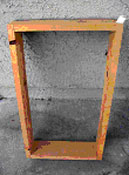
Potting Mix Sieve
|

Potting Mix Sieve
|
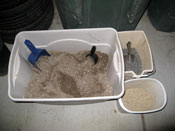
Storage Bins and Trash Cans
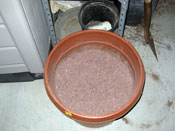
Large Sturdy Pots
|
5a. Pails, Buckets and Storage Boxes
Obviously these are in everybody's backyard, but how do you use them? I actually use some small plastic trash cans as
mixing buckets. I use 4 or 5 different ones, each with its own media. I also use a large storage box as my final
container for my soil mix. It just makes it easier to grab and pour equal amounts into the final mix bin with the
buckets. Messing with bags and not having good control over the amount coming out, makes the multiple buckets
worthwhile. Large sturdy pots also make good storage bins. I recycled a plastic sand bag and reassigned it to liner
duty for this pile of lava rocks.
Storage boxes make great seedling trays and incubators. I finally found one with a clear top at Target.
5b. Ziploc baggies
Ziploc baggies have many useful duties. Can be used for seed germination and for storing seeds and fruit. Most
Ziplocs come with a handy label area.
|
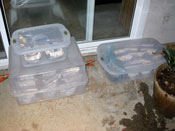
Clear storage bins for seedlings
|
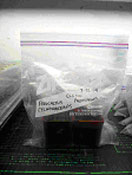
Ziploc baggies for seedlings
|
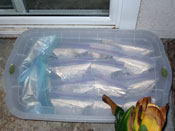
Clear storage bins for seedlings
|
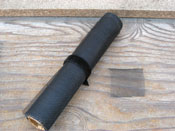
Window Screen
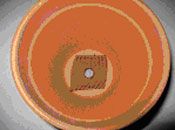
Window Screen in Pot
|
6a. Window screen
Used for covering the hole(s) in the bottom of the pots to avoid soil loss. I found replacement window screen
(48in. x 56in.) for a mere $7 at Home Depot. It comes rolled in a tube and is easy to cut into more manageable
lengths. Cut into small squares and set in the bottom of each pot, covering the hole. Imagine just how many pots
this large piece of screen can be used for!!!
Another way to cover the pot holes would be coffee maker filters. They will decompose over time, but the soil has
time to become compacted with roots in that time.
Window screen can also be used as a shadecloth. Used for individual plants that are prone to sunburn or whenever a
little shade is needed on a plant or seedling tray.
6b. Other Potting tips
Making a larger hole in the center of the pot bottom can later be used to push the plant up from the bottom using
a dowel stick. Window screen or other means can be used to cover the hole to retain the soil mix
until it's needed.
|
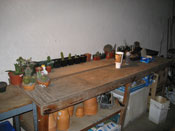
Workbench
|
7. Workbench / Work Areas
My workbench is a leftover relic from the garage, but works very well for my needs. It's even titled away from
the wall, so the water runs off!
|

2 Liter Soda bottle
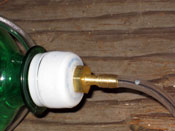
Brass Fitting and Pour Tube
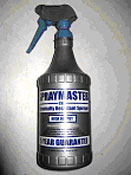
Spray Bottle
|
8. Watering containers
I've been trying to figure out a good way to water my potted plants without disturbing the soil and/or top dressing.
I've been using a large cup, but find that with plants that take up a good portion of the pot, or have a lot
offsets/pups hanging over or whatever the case, I seem get more water on the plant, than in the soil.
So I've come up with a nifty idea using large plastic 2L soda bottle with a hard plastic top. (i.e. 1 gal
drinking water bottle, 2liter soda bottle) Using a flexible .25inch rubber tube attached to the screw-on top,
simply fill with water, turn upside down and BAM! an easy snake tube to get the water under, around and into
the tight spots to get into the soil where it belongs.
Another good tool to have is a few spray bottles. Used for misting seedlings, applying fertilizer and
pesticides/fungicides. I use separate bottles for watering and insecticides. It's a good idea to
label your bottles. O good cleaning once every other month with bleach is also a good idea. Spray bottles
can also be found in discount packs of 3-6 in most home improvement stores.
|

Ferocactus Carpet Transporter

Pot Grippers
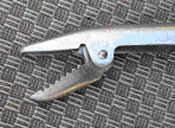
Pot Grippers
|
9. Large plant carriers, handlers
Another way to transport/move larger plants is to use a scrap piece of carpet. Wrapped around the plant in a sling
fashion, makes for easy moving. Other useful tools can be newspaper or butcher paper folded tightly and used as a
belt/sling. Scrap pieces of shade cloth folded tightly can also be used in a belt/sling manner. These can also
be used for handling smaller plants.
A really handy tool, pot grippers. When reaching for a pot in the middle of the greenhouse bench, it's almost
inevitable you'll get poked by neighboring spines. These pot grippers make it easy to reach in and grab the pot
of the plant you're after and it's totally painless!! Very strong grip, able the pick up 6.5" pots.
|

Telescopic and Adjustable Angle Mirror
|
10. Magnifying glasses and Mirrors
A good tool to have is a magnifying glass for up close inspection for pests and insects along with minute damage etc.
Another nifty tool, is a telescoping mirror with a swivel head for those hard to reach/see areas. These can be
found in automotive parts stores.
|

Brother P-Touch Label Maker
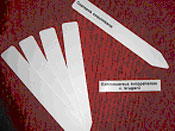
Labels
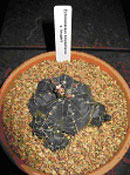
The Final Product
|
11. Label Makers
It's a neat and tidy way (and always legible) to label your plants pot labels. For example, the Brother P-Touch
label maker. They run on batteries or a wall plug, and being portable makes them very convenient. You can have it
right there with you on your workbench and print the labels out as you repot. There are various widths of tape
for almost any plastic label out there. The tape comes in 2 colors. (or maybe more, but I've only seen 2) Both
have black text on either clear or white tape. The tape backing is conveniently split lengthwise for easy
peeling. These label makers are not that inexpensive however. They go for $20-40 and refill tape cartridges
go for around $10-12. For a large collection, expect to go through many cartridges. But once you have them all
labeled, the cartridges will last longer. I really like the professional look of the printed labels and there's
never any questionable handwriting to decipher. None of that, "Is that an I, an L or a 1�????" The adhesive
is very strong and since the labels are thermo printed, they are water resistant and are fade resistant when
sitting out in the hot southwest summer sun. However, they do peel off the plastic sticks pretty easily and
don't seem to leave much, if any adhesive residue behind, enabling you to reuse the plastic sticks without any cleanup.
Of course, they are not only useful for label sticks, but have 100's of other uses as well. So the
money investment is not all lost.
|
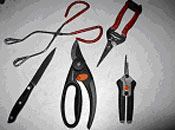
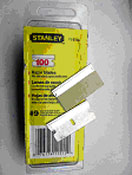

|
12. Misc. tools
Now, these are really common tools, but to make this article complete, i feel compelled to mention them anyway.
Hand Trowel
Pruning shears
Sharp utility knife
Small hand saw
Scissors
Alcohol for sterilizing cutting tools
Identi-pen marker found at Michaels Art Supply stores. Does not fade like a sharpie marker. A #2 pencil can also be used and resists fading quite well.
Ziploc bags
Coin envelopes are great for storing and labeling cleaned/collected seeds.
Sharpie marker for ID labels on Ziploc bags for seedlings or seed/fruit collection.
Plant ID labels
Gloves
Kneeling pad
Roll of 1/4in. Velcro (for attaching limbs/stems to a stake for easy removal/relocating and no harm done to the plant)
|
Author: Darryl Craig
Website: CoronaCactus.com
|